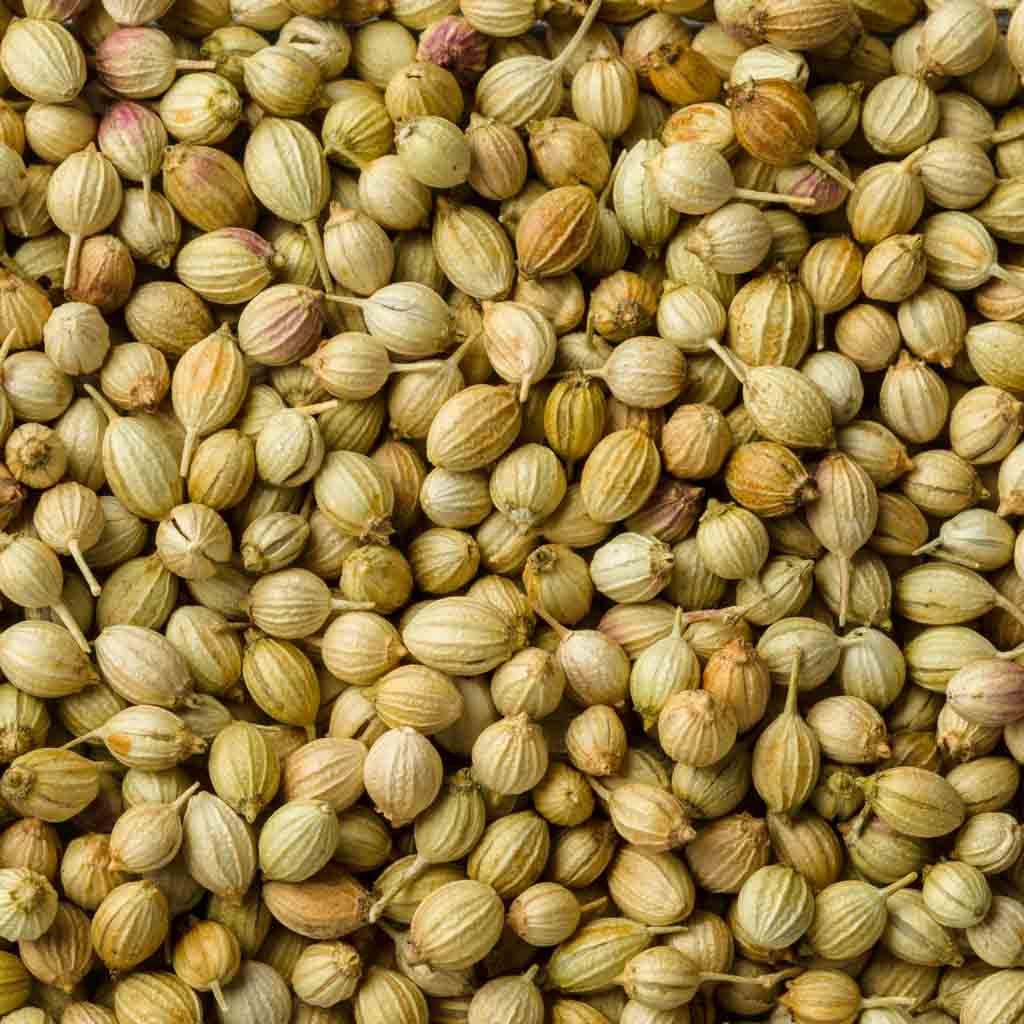Coriander Coriandrum sativum seeds in Bulk packaging Shipped in 20″ FCL Container
Login to view prices
Common name: Coriander.
Latin name: Coriandrum sativum L.
Family: Apiaceae (Umbelliferae)
Other names: Arab: kuzbara, kuzbura; Armenian:chamem; Chinese: yuan sui, hu sui; Czech: koriandr; Danish: koriander; Dutch: koriander; English: coriander, collender, chinese parsley; Ethiopian: (Amharic) dembilal; French: coriandre, persil arabe; Georgian (Caucasus): kinza, kindza, kindz; German: Koriander, Wanzendill, Schwindelkorn; Greek: koriannon, korion; Hindi: dhania, dhanya; Hungarian: coriander; Italian: coriandolo; Japanese: koendoro; Malay: ketumbar; Persian: geshnes; Polish: kolendra; Portugese: coentro; Rumanian: coriándru; Russian: koriandr, koljandra, kišnec, kinza, vonjučee zel’e, klopovnik; Sanskrit: dhanayaka, kusthumbari; Serbokroatian: korijander; Spanish: coriandro, cilantro, cilandrio, culantro; Swiss: Chrapfechِörnli, Böِbberli, Rügelikümmi; Turkish: kişniş
Botanical Origin:
Common name: Coriander.
Latin name: Coriandrum sativum L.
Family: Apiaceae (Umbelliferae)
Other names: Arab: kuzbara, kuzbura; Armenian:chamem; Chinese: yuan sui, hu sui; Czech: koriandr; Danish: koriander; Dutch: koriander; English: coriander, collender, chinese parsley; Ethiopian: (Amharic) dembilal; French: coriandre, persil arabe; Georgian (Caucasus): kinza, kindza, kindz; German: Koriander, Wanzendill, Schwindelkorn; Greek: koriannon, korion; Hindi: dhania, dhanya; Hungarian: coriander; Italian: coriandolo; Japanese: koendoro; Malay: ketumbar; Persian: geshnes; Polish: kolendra; Portugese: coentro; Rumanian: coriándru; Russian: koriandr, koljandra, kišnec, kinza, vonjučee zel’e, klopovnik; Sanskrit: dhanayaka, kusthumbari; Serbokroatian: korijander; Spanish: coriandro, cilantro, cilandrio, culantro; Swiss: Chrapfechِörnli, Böِbberli, Rügelikümmi; Turkish: kişniş
Description:
Coriandrum sativum L is an annual hapaxanthic bright green herb with erect and glabrous (hairless) branching stem, growing to a height of about 2 ft. and carrying compound leaves. The compound lower leaves are roundish and lobed, while the upper leaves are finely divided into very narrow, lacy segments. At flowering, the glabrous plant can reach heights between 0.20 and 1.40 m.
The small flowers, which appear in june, are white or rose colored; the fruit is globular and composed of two concavo-convex mericarps. The fruit, or, as it is commercially called, the seed, ripens in August.
The overground parts of the green plant, particularly the leaves, possess a peculiar rather disagreeable odor. However a pleasant, warm, somewhat spicy aroma distinguishes the mature dried seed.
Range & Habitat:
The world-wide production of coriander may be estimated at approximately 550,000 ha annually. The yearly production of coriander fruits may be estimated at about 600,000 tons. The main producers of coriander fruits are the Ukraine, Russia, India, Morocco, Argentina, Mexico and Romania. Other countries that produce at least some coriander for use of the fruits, by geographical region, are:
– the Near East (Iran, Israel, Kuwait, Lebanon, Syria and Turkey)
– the Middle East (Bhutan, Kasachstan, Kirgysia, Pakistan and Tadjikistan)
– the Far East (Burma, China and Thailand)
– the Americas (Argentina, Chile, Costa Rica, Guatemala, Paraguay, USA and
Canada)
– Africa (Algeria, Egypt, Ethiopia, Somalia and Tunisia)
– Europe (Bulgaria, Czechoslovakia, England, France, Hungary, Italy, the Netherlands,
Poland and Yugoslavia).
Coriander is well suited to growing on a range of soils, but it performs best on well-drained loam and sandy-loam soils. Suitable pH ranges are from 4.5 to 8.0, with an optimum of 6.3. Although the crop is heat loving, it has an optimum growing temperature of 18° C.
The large-seeded coriander requires a shorter time to maturity than the small-seeded cilantro. Hot, dry winds during flowering (anthesis) can lead to the dropping of flowers, resulting in substantial yield reduction.
Researchers in Europe have noted that the quantity of oil increases as production occurs farther north in the northern hemisphere. It has also been noted that volatile oil content increases during cool, moist summers. The use of honeybees as pollinators can improve coriander seed yield.
The reported life zone of coriander is 7 to 27° C with an annual precipitation of 0.3 to 2.6 meters and a soil pH of 4.9 to 8.3. Coriander thrives in full sun and grows best in deep fertile loams with adequate drainage. The plant is tolerant to cold, heat and drought stresses. Coriander adapts itself easily to any kind of soil.
Planting & Cultivation:
Row spacing can be 6 to 12 in. (15 – 30 cm) with a seeding depth of 1 to 1.5 in. (2.5 – 4.0 cm). Time of sowing can vary between late-April and mid-May or even at March benefiting from the winter humidity of the soil. Sowing can be done with conventional equipment, but press drills appear to produce the best results on a moist, firm seedbed when the danger of frost is over. It is critical that seeding be done on an absolutely clean weed free field because the crop may take a long time to emerge. The seeds germinate well and evenly within 8 to 10 days.
The seeding rate for coriander production is generally 13 to 22 lb/ac (15 – 25 kg/ha), with 19 lb/ac being the optimal rate.
The cultural care begins right after sprouting of the seed. At first the young plants develop very slowly but as soon as they have taken root they grow almost visibly. After the plants have reached a height of about one span (23 cm) they are hoed for the second time. From then on the plants grow rapidly, the leaves protecting the ground around the plants so well that further care is not necessary. If the seed is sown at a greater row distance, e.g. 36 – 37 cm., a cultivator can be used instead a hoe.
When not yet matured, coriander has a strong, peculiar, and disagreeable odor.
Harvesting and Preparing for the Market:
Coriander should be swathed when 80 per cent of the seeds turn purple-brown. Swathes should not be left out too long due to the potential for shattering. Swathing when there is dew or high humidity will reduce shattering losses.
Combining is usually done when seed moisture content is less than 15 per cent. Ten per cent moisture is considered dry, but buyers prefer nine per cent. Cylinder/rotor speeds should be set at approximately 500 rpm under dry conditions. An initial setting of 0.5 in. (20 mm) at the front and 0.25 in. (10 mm) at the back is suggested. Wind speed should be reduced to the minimum, and ground speed should be slowed.
Coriander oil is very volatile, so the seed must be dried gently; avoid hot air drying. Aeration is useful for reducing moisture content; however, coriander seed readily takes up other odors, so store away from gasoline, herbicides, etc. Remove green material such as weed seeds as quickly as possible, since aeration will be diverted around these areas in the storage bin, resulting in the potential for spoilage.
The sample must be free of rodent droppings and have very low foreign material (2 per cent). If samples have greater that 5 per cent split fruit, the shipment is usually discounted by the buyer.
Yield of seed per Acre:
350 to 850 Kg of coriander seeds are produced per acre.
Export Markets:
We export our products to many countries all over the world. USA, France, Germany, China, Malaysia, Algeria, Morocco, Indonesia…etc
Quotation:
- Incoterms: FOB
- Quantity: one 20″ FCL Container Minimum
- Specification: 100% natural and Pure quality
- Documentation: COA, MSDS, TDS, GC Peaks
- Packaging: Bulk Packaging
- Payment terms: TT in advance to Our bank account
- Lead time: Shipping through 10 days from receipt of the payment.
- Sea Shipping Time: 35 days
- Air shipping time: 10 days
Quality Certificates:
- ISO 9001-2015
- ISO 22000-2005
- GMP accredited by AQC Middle East FZE
- KOSHER Certificate
- Halal Certificate
- ORGANIC Certificate accredited by CERES GmbH Germany
- NOP Certificate accredited by CERES GmbH Germany
- Egyptian Ministry of Health Permission
Contact us please to receive other supporting documents for our Oils :
- COA
- MSDS
- TDS
Branding Services
We also can do customized packaging for you to pack whatever size you like. We can help in designing labels, selecting good packets or bags. We deliver integrated solutions under your brand..
Organically Certified product Available upon request
Additional information
| Weight | 12000 kg |
|---|---|
| Dimensions | 610 × 244 × 259 cm |
| Country of Origin | China, India, Egypt |
| 20 Container Capacity H | 8000 kg |
| Ship from | China, Egypt, India |
| Herbs Packaging | PE bags 25 Kg, PE Bags 50 kg, Paper Bag 25 kg, Paper Bag 50 kg |
| Cultivation Type | Organic, Conventional |
| HS Code | 09109990 |
| Custom Branding & Packaging | Yes, OEM Custom banding, designing and packaging are available for that product |
| Herbal OEM Packaging | Kraft Bag, Kraft Bag with transparent window, Kraft bag with open side, Glass Jar, Glass jar Spices with holed lid, Tea bag, Tea bag with paper bag, Tea Cylinder packaging, Tin Packaging |
| Documentation & Certifications | Allergen Free Certificate, Bovine Spongiform Encephalophathy (BSE) Certificate, GMO Certificate, GRAS Status Statement, Herbal Origin Statement, Organic Certificate, Pesticide Residual Certificate, Halal Certificate, KOSHER Certificate, Researches & Studies, Certificate of Analysis (COA), Technical Data Sheet (TDS) |
-
Login to view prices
Fennel Foeniculum vulgare Seeds in Bulk packaging Shipped in 20″ FCL Container
Login to view prices Read more -
Login to view prices
Dill Seeds Anethum graveolens in Bulk packaging Shipped in 20″ FCL Container
Login to view prices Read more -
Login to view prices
-
Login to view prices





